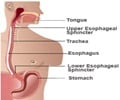Esomeprazole Medication Information
Learn everything you need to know about Esomeprazole-pronunciation, uses, dosage guidelines, indications, and when to take or avoid it.
Get up-to-date information on side effects, precautions, warnings, and proper storage to ensure safe usage.
Explore Esomeprazole brand names commonly used in India and internationally, along with detailed pricing information. Consult your healthcare provider for tailored medical advice.
Generic Name : Esomeprazole Pronunciation : ES-oh-MEP-ra-zole ICD Code : Y53.0 Therapeutic Classification : AntiulcersBrand Names or Trade Names of Esomeprazole
India :
International :
Nexium I.V.
Why is Esomeprazole Prescribed? (Indications)
This medication is a proton pump inhibitor (PPI), prescribed for gastroesophageal reflux disease (GERD). With amoxicillin and clarithromycin it is used for treatment of Helicobacter pylori infection and duodenal ulcer. It is also used to aid in reduction in occurrence of gastric ulcers associated with continuous NSAID therapy, and in Zollinger-Ellison syndrome. It blocks the production of stomach acid.When should Esomeprazole not be taken? (Contraindications)
Hypersensitivity.♦ It should not be co-administered with Methotrexate, clopidogrel and atazanavir.
What is the dosage of Esomeprazole?
GERD: 20 or 40 mg is given once daily for 4-8 weeks. In children ages 1-11, the dose is 10 or 20 mg daily.H. pylori: 40 mg is administered once daily in combination with amoxicillin and clarithromycin for 10 days.
NSAID-induced ulcers: 20 to 40 mg daily for 6 months.
Zollinger-Ellison syndrome is treated with 40 mg twice daily.
How should Esomeprazole be taken?
It comes as a tablet or capsule to take by mouth, once a day, one hour before meal.What are the warnings and precautions for Esomeprazole?
•Caution needed for children, pregnancy and breastfeeding women.• It may cause malignancy and liver impairment.
While taking this medication, there is an increased risk of developing certain infections such as community-acquired pneumonia.
What are the side effects of Esomeprazole?
Central Nervous System- Headache, dizziness, drowsiness, aggression, agitation, depression, hallucination.Skin- Itching, hair loss, severe allergic reactions, photosensitivity, blistering.
Eye and ENT- Blurred vision.
Gastrointestinal- Flatulence, abdominal pain, stomach upset, nausea, diarrhea, dry mouth, constipation, GI fungal infection, inflammation of pancreas and intestine, mouth ulcer, taste disturbance.
Genitourinary- Breast enlargement in men, kidney disorder.
Liver- Occurrence of confusion, altered level of consciousness and coma as a result of liver failure(Hepatic encephalopathy) , liver failure, inflammation of liver with or without jaundice.
Blood- Decrease in white blood cells.
Local- Injection-site reactions including mild local redness and itching with IV administration.
Musculoskeletal- Muscular weakness, muscle pain.
Respiratory- Asthma, respiratory tract infection.
Miscellaneous- Severe allergic reaction/shock.







